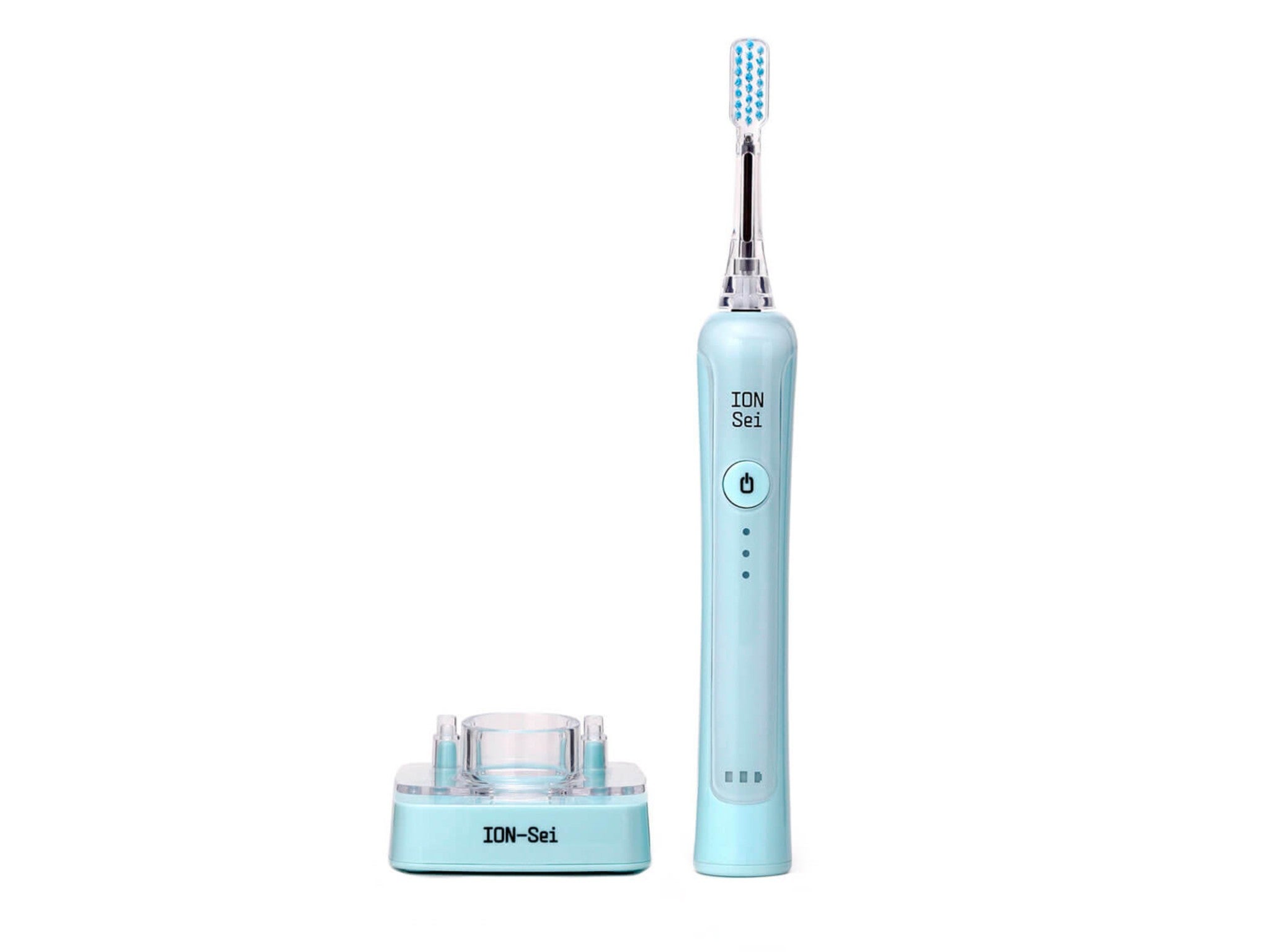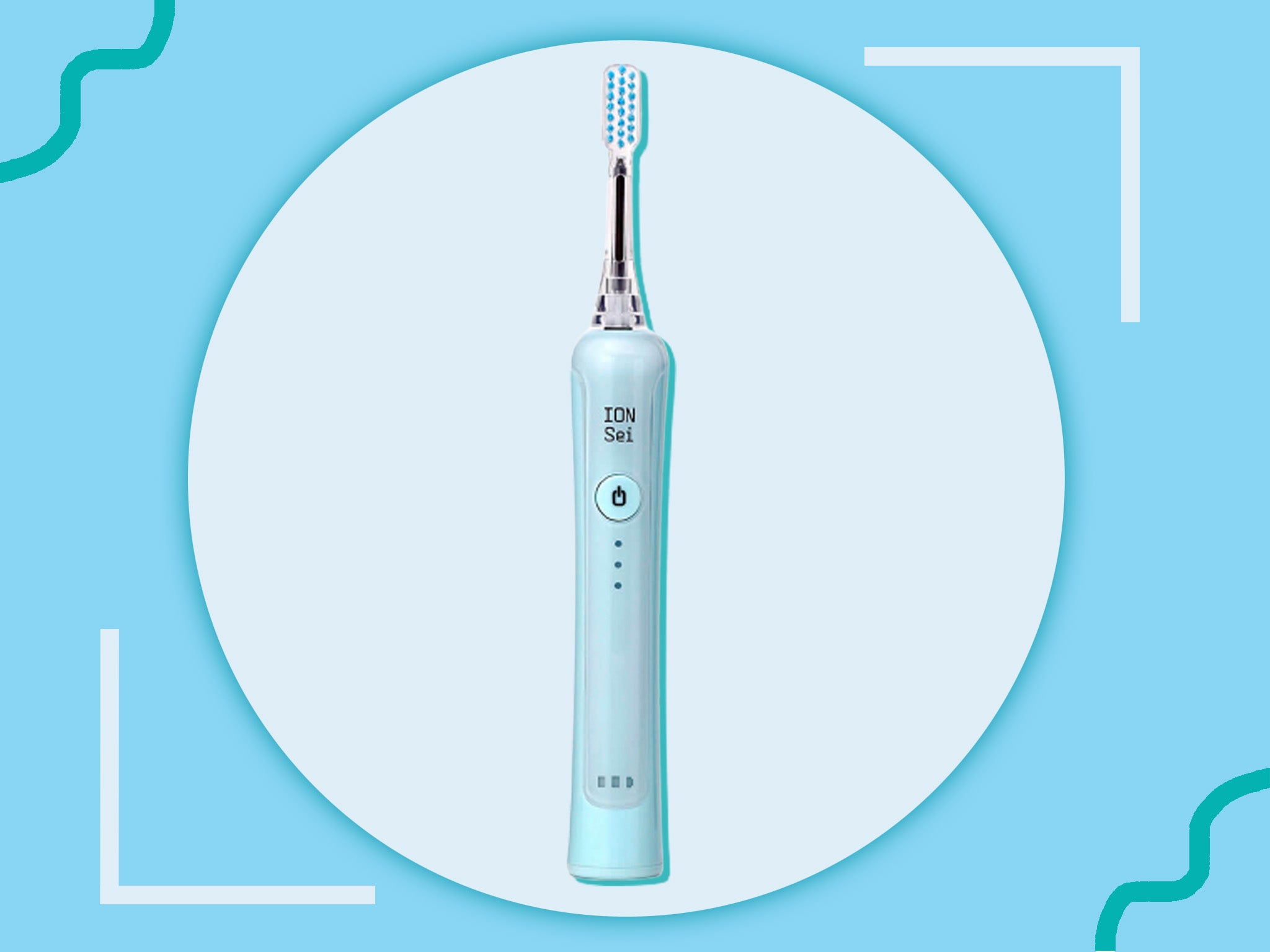Sanyei ion-sei electric toothbrush

Buy now £128.67, Amazon.co.uk
- Cleaning technology: Sonic
- Warranty? No
- 30-second pacer? Yes
- 2-minute timer? Yes
- Pressure sensor? No
- Travel case? No
- Waterproof? Yes
- Brushing modes: 3
- Weight: 96g
- Charging time: 10 hours
- Usage: 40 x 2-minute cleans
The design
The brush is now available in a new product colour – “moon grey” – which you can choose alongside “day white” or “lake blue”. According to Sanyei, the ion’s “holistic design is inspired by Japanese culture and organic lines”, which probably isn’t something you’ll give too much thought to when you enter the bathroom, bleary-eyed, in the morning.
However, the brush is certainly eye-catching, if a little bulky looking, but feels robust and ergonomic with the rigid panel – that is an electric conductor – providing a tactile grip that’ll stop the brush getting slippery when wet.
The titanium dioxide bar encased in plastic and the UV light also make the brush stand out from the crowd and serve as a reminder that this is a totally new approach to dental hygiene.
The science
The negative ions that are at the core of the ion-sei’s plaque-zapping technique are generated in two ways. Firstly, by “body circuit flow” when you first grab the handle – or, more specifically, the black, rigid conductor panel on the back of the brush that is connected to a titanium dioxide bar in the handle. This conductor taps into your body’s own electrical charge to create a weak current that produces the first wave of negative ions. The second wave is generated through something called a “photocatalytic reaction”, which is a natural chemical process that occurs when a light source interacts with the surface of the titanium dioxide bar that is exposed in the transparent neck.
When the brush is powered up you’ll see the LED light come on so you know that both processes are underway and the ions are going to work as soon as the brush head enters your mouth. This is when the negative ions seek out the electrons found in plaque and bacteria molecules on and around the teeth and in gum pockets, apparently weakening their bonds and allowing them to be more easily removed by the sonic action of the brush head.
Read more: 9 best kids’ electric and manual toothbrushes
Your teeth are then left coated in negative ions, rather than fluoride, a process that Sanyei calls “ionic protection”, claiming that it’s clinically proven to have an antibacterial effect against plaque-causing bacteria as the negative ions left behind on teeth actively repel any further bacteria, which is also negatively charged, in the same way that magnets repel one another when their negative charges meet.
The 2018 clinical study data, which was commissioned by the Sanyei corporation, is available on the ion-sei website.
In use
Now, you might have noticed that we mentioned that the brush works by coating your teeth in negative ions rather than fluoride, because the ions that it produces are optimally carried into and around your mouth using water and saliva only – that means no toothpaste is required. In fact, the manufacturers claim that toothpaste can actually inhibit the effectiveness of the brush.
This may seem rather counterintuitive, and we can vouch for the fact that it does feel very strange brushing without the foaming effect of fluoride and the minty aftertaste that would usually signify that your teeth are “clean”.
However, we persevered over a number of weeks, forcing ourselves to relearn how we brush in the morning and evening and form a new habit.
It was never going to be easy and in the end we could never fully break our reliance on our tube of the white stuff and opted to spend two minutes of brushing without the toothpaste to get the benefits of the ionic protection and then one final minute with toothpaste, extending our time with the brush to three minutes morning and evening.
Read more: Oral-B iO7 vs Oral-B iO9: Which smart electric toothbrush is best?
This compromise worked well as the ion-sei is a very efficient sonic brush that compared well to the sonic actions of the brushes in the Philips sonicare range. In fact, we would say that the brush is one of the best “sonics” we’ve tested which, in combination with nicely textured bristles, leave teeth feeling thoroughly cleaned and polished without being overly harsh on the gum line.
In terms of more general usage, even though the toothbrush looks heavy, it’s actually very light in hand and feels more like a manual than an electric, with a heavy motor powering the brush head, while the electric conductor handle is comfortable to use.
There are three brushing modes – sensitive, standard and deep, each of which cycles through different strokes per minute ranging from 18,000spm to 31,000spm, so there’s plenty of scope to find an operating mode that suits your dental regime.
Repeatedly pressing the power button will jump you from one mode to the next, indicated by one, two or three LEDs on the handle, and the brush will store the last setting you used, so, when you turn the brush on before bed in the evening, it will begin with the mode you used that morning.
The USB charger was easy to use with a full charge – which took around four hours – and lasted for 80 minutes, which worked out to around 14 days of use with our three-minute regime.
As with almost all electric toothbrushes these days, there are quadrant cleaning warnings and 30-second pauses to help guide your technique, although you don’t get a pressure sensor or brush-head replacement reminders, so this might be a consideration if those features are important to you.
The verdict: Sanyei ion-sei electric toothbrush
The ion-sei encourages you to rethink how you brush your teeth and whether you buy into the science or not, it’s still a very effective and comfortable sonic toothbrush. We’re of the opinion that any tool which might break up bacteria populations in the mouth and reduce the damage that they can do is a good thing, and so taking advantage of the excellent sonic action of the brush with toothpaste, in combination with the negative ion processes, is the best way to ensure that you get the most out of the brush’s technologies.
